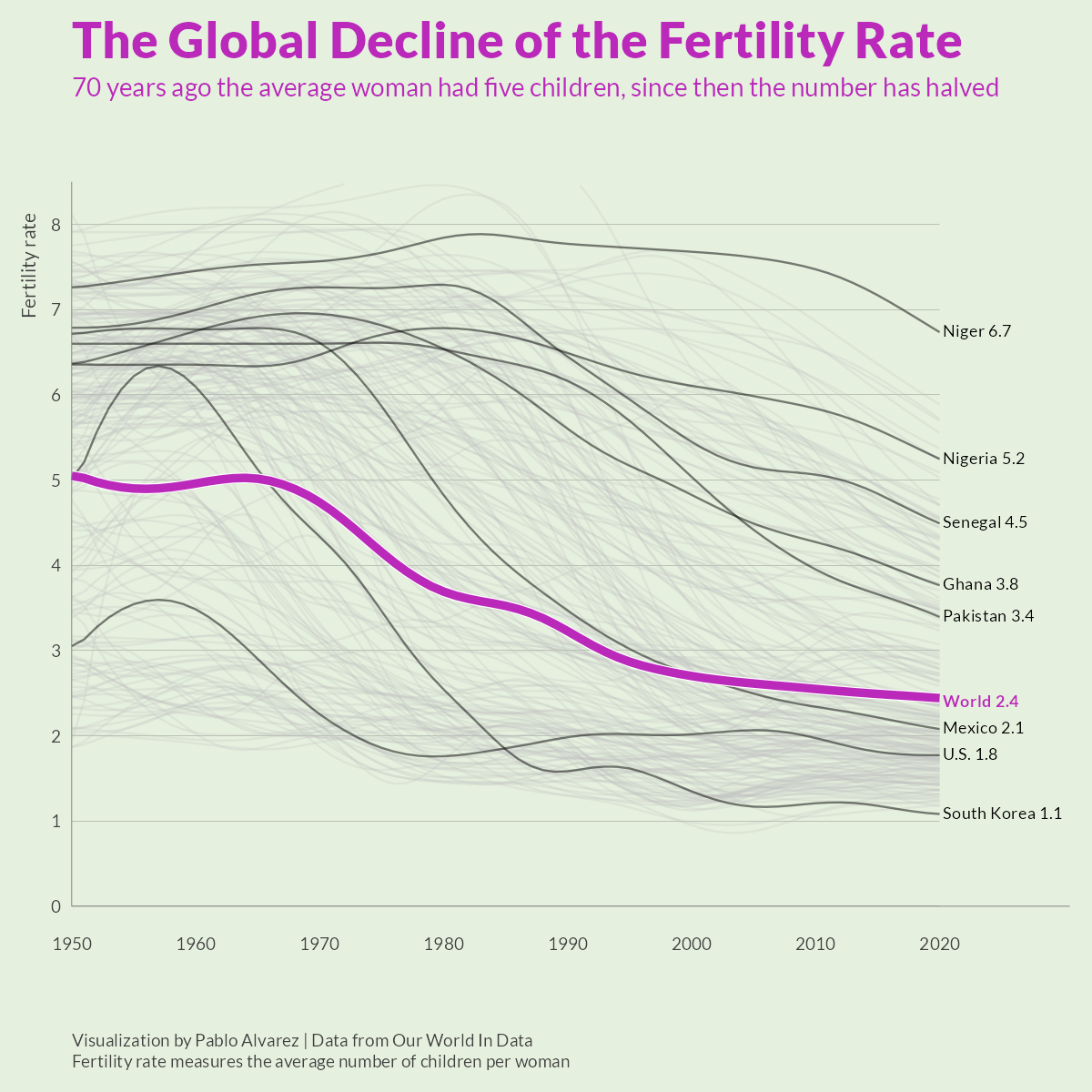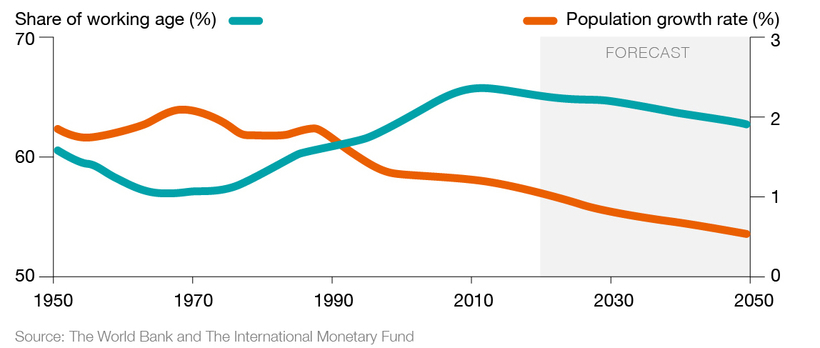Charted: The Global Decline Of Fertility Rates

Charted: The Global Decline of Fertility Rates
Over the last 50 years, fertility rates have dropped drastically around the world. In 1952, the average global family had five children—now, they have less than three.
This graphic by Pablo Alvarez uses tracked fertility rates from Our World in Data to show how rates have evolved (and largely fallen) over the past decades.
What’s The Difference Between Fertility Rates and Birth Rates?
Though both measures relate to population growth, a country’s birth rate and fertility rate are noticeably different:
- Birth Rate: The total number of births in a year per 1,000 individuals.
- Fertility Rate: The total number of births in a year per 1,000 women of reproductive age in a population.
As such, the fertility rate is a more specific measure, which as Britannica highlights, “allows for more efficient and beneficial planning and resource allocation.” Not including immigration, a given area needs an overall total fertility rate of 2.1 to keep a stable population.
Global Fertility Rates since 1952
For the last half-century, fertility rates have steadily decreased worldwide. Here’s a look at the average number of children per woman since 1952:
| YEAR | AVERAGE # OF CHILDREN PER FAMILY | % CHANGE (Y-O-Y) |
|---|---|---|
| 1951 | 5.0 | -0.5% |
| 1952 | 5.0 | -1.4% |
| 1953 | 4.9 | -0.7% |
| 1954 | 4.9 | -0.5% |
| 1955 | 4.9 | -0.3% |
| 1956 | 4.9 | -0.1% |
| 1957 | 4.9 | 0.1% |
| 1958 | 4.9 | 0.3% |
| 1959 | 4.9 | 0.4% |
| 1960 | 5.0 | 0.5% |
| 1961 | 5.0 | 0.5% |
| 1962 | 5.0 | 0.4% |
| 1963 | 5.0 | 0.3% |
| 1964 | 5.0 | 0.1% |
| 1965 | 5.0 | -0.2% |
| 1966 | 5.0 | -0.5% |
| 1967 | 5.0 | -0.8% |
| 1968 | 4.9 | -1.1% |
| 1969 | 4.8 | -1.4% |
| 1970 | 4.7 | -1.8% |
| 1971 | 4.6 | -2.1% |
| 1972 | 4.5 | -2.5% |
| 1973 | 4.4 | -2.7% |
| 1974 | 4.3 | -2.9% |
| 1975 | 4.2 | -2.9% |
| 1976 | 4.0 | -2.8% |
| 1977 | 3.9 | -2.7% |
| 1978 | 3.8 | -2.4% |
| 1979 | 3.8 | -2.1% |
| 1980 | 3.7 | -1.7% |
| 1981 | 3.6 | -1.3% |
| 1982 | 3.6 | -1.0% |
| 1983 | 3.6 | -0.8% |
| 1984 | 3.6 | -0.7% |
| 1985 | 3.5 | -0.8% |
| 1986 | 3.5 | -1.0% |
| 1987 | 3.4 | -1.4% |
| 1988 | 3.4 | -1.7% |
| 1989 | 3.3 | -2.1% |
| 1990 | 3.2 | -2.4% |
| 1991 | 3.1 | -2.6% |
| 1992 | 3.1 | -2.6% |
| 1993 | 3.0 | -2.4% |
| 1994 | 2.9 | -2.2% |
| 1995 | 2.9 | -1.8% |
| 1996 | 2.8 | -1.5% |
| 1997 | 2.8 | -1.3% |
| 1998 | 2.8 | -1.1% |
| 1999 | 2.7 | -1.1% |
| 2000 | 2.7 | -0.9% |
| 2001 | 2.7 | -0.9% |
| 2002 | 2.7 | -0.7% |
| 2003 | 2.6 | -0.6% |
| 2004 | 2.6 | -0.6% |
| 2005 | 2.6 | -0.5% |
| 2006 | 2.6 | -0.5% |
| 2007 | 2.6 | -0.5% |
| 2008 | 2.6 | -0.5% |
| 2009 | 2.6 | -0.5% |
| 2010 | 2.5 | -0.5% |
| 2011 | 2.5 | -0.5% |
| 2012 | 2.5 | -0.5% |
| 2013 | 2.5 | -0.5% |
| 2014 | 2.5 | -0.4% |
| 2015 | 2.5 | -0.4% |
| 2016 | 2.5 | -0.4% |
| 2017 | 2.5 | -0.4% |
| 2018 | 2.5 | -0.4% |
| 2019 | 2.5 | -0.4% |
| 2020 | 2.4 | -0.4% |
Why are women having fewer children? There are a number of theories and empirical research studies to help explain this decrease, but according to Dr. Max Roser, the founder of Our World in Data, most of the literature boils down to three main factors:
- Women’s empowerment, particularly in education and the workforce
- Lower child mortality
- Increased cost to raising children
Research has found that higher education in women is correlated with lower fertility. For instance, in Iran in the 1950s, women had an average of three years of schooling and raised seven children on average.
But by 2010, when Iranian women had nine years of schooling on average, the average fertility rate in the country had dropped to 1.8.
This theory is further supported when you look at countries where women’s education is still relatively lagging. For instance, in 2010, women in Niger had 1.3 years of education on average, and an average of more than seven children—more than double the global average at that time.
The Societal Impact
Lower fertility rates, coupled with increased life expectancies around the world, are creating an aging population. Since 1950, the global median age has grown from 25 years to 33 years.
An older population comes with a number of economic risks, including rising healthcare costs and a smaller global workforce.

According to a report by the World Bank, the world’s working-age population peaked back in 2012. Since then, it’s been on the decline.
A smaller working population puts more pressure on those who are working to support those who are collecting pensions. This could ultimately lead to an economic slowdown if countries don’t prepare and alter their pension systems accordingly, to account for our aging population.
Disclosure: None.



